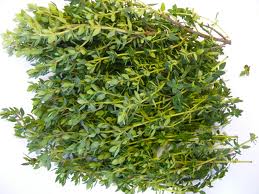Thyme
Like
most herbs, thyme can successfully and relatively easy be grown
indoors, it needs only a bright windowsill and some basic attention to
thrive. In general, even though it's a perennial, I find that thyme is
a short-lived plant, in part because we eat it so quickly. You can
propagate thyme fairly easily, but there's really no need to do so.
With pots of young thyme readily available (even in grocery stores),
it's a simple matter to keep a thyme plant alive while you slowly
consume it, and then replace it when the plant begins to look weak.
Growing Conditions:
Light: Thyme
prefers bright light or full sun. I have excellent success on an
east-facing windowsill. It can also be grown fairly easily under
standard or compact fluorescent lights for a year-round supply.
Water: Water regularly, but not excessively. Let the soil slight dry between waterings. Thyme is naturally drought resistant.
Temperature: Average. Thyme is a hardy plant that will thrive down to 50˚F and up to 80˚F or higher.
Soil: Airy, light, fast-draining soil.
Fertilizer: Use liquid fertilizer, or supplement the soil with controlled-release pellets. For organic thyme, use an organic fertilizer or fortify soil with compost.
Water: Water regularly, but not excessively. Let the soil slight dry between waterings. Thyme is naturally drought resistant.
Temperature: Average. Thyme is a hardy plant that will thrive down to 50˚F and up to 80˚F or higher.
Soil: Airy, light, fast-draining soil.
Fertilizer: Use liquid fertilizer, or supplement the soil with controlled-release pellets. For organic thyme, use an organic fertilizer or fortify soil with compost.
Propagation:
Thyme
can be easily propagated from leaf-tip cuttings or division of mature
plants. To divide a large plant, remove the plant from the pot and
gently tease apart the root ball and stems, then plant each ball into
its own pot. In most cases, however, it's usually easier to simply
discard older, woody plants and buy new thyme plants. Thyme can also be
readily grown from seed, which opens up a larger selection, such as
lemon or Spanish thyme. Thyme seeds germinate in one to three weeks.
Repotting:
Most
thyme plants are only repotted after their initial purchase, perhaps
stepping up from the 4" nursery pot into a 6" pot, which is plenty
large enough to support a thriving and healthy thyme plant. Older
plants develop a woody stem. My advice is to divide older plants at
repotting time and place back into 6" pots with fresh soil—there is no
reason to grow thyme in larger pots for kitchen use, especially if the
thyme is part of a collection of kitchen herbs.
Varieties:
As
one of the world's oldest aromatherapy and medicinal plants (it's been
in cultivation since the ancient Greeks), there are many varieties of
thyme. The most popular is the common thyme, or Thymus vulgaris. This
plant is sometimes also called French thyme (although not exclusively).
Other popular varieties include the citrus thymes, which are cultivars
with a distinct citrusy aroma and flavor. Lemon thyme in particular is
a wonderful herb. Other varieties include orange thyme and variegated
thyme. Some forms of thyme are used as groundcovers and are important
sources of nectar for honeybees, but are not edible themselves.
Grower's Tips:
Thyme
is not a difficult plant to grow. In outdoor gardens, it's frequently
used in xeriscaping or hot, dry locations where other plants have
trouble thriving. It's hardy in USDA zones 4 to 9, although it can be
grown in Zone 10 in the winter months. It can even tolerate light
frosts in higher elevations. Indoors, the biggest challenge you'll
probably face is providing consistently bright light and avoiding
pests. Obviously, because it's an herb, you'll want to avoid as many
pesticides and chemicals as possible. Thyme is prone to whireflies and
mealy bugs. Use
neem oil where necessary, being careful to follow label instructions.



